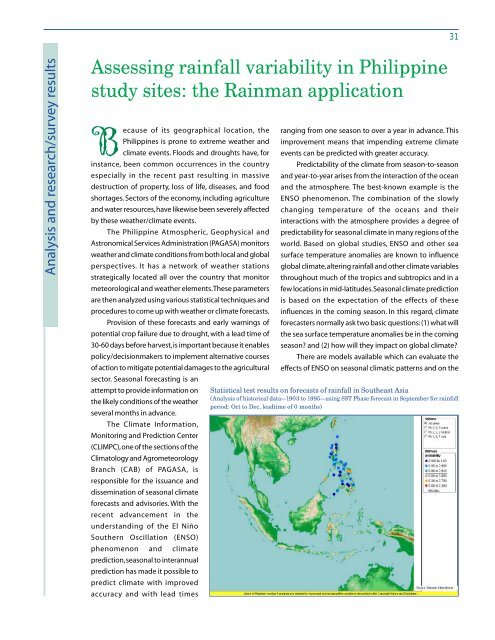Read More - Philippine Institute for Development Studies
Read More - Philippine Institute for Development Studies
Read More - Philippine Institute for Development Studies
Create successful ePaper yourself
Turn your PDF publications into a flip-book with our unique Google optimized e-Paper software.
31<br />
Analysis and research/survey results<br />
Assessing rainfall variability in <strong>Philippine</strong><br />
study sites: the Rainman application<br />
Because of its geographical location, the ranging from one season to over a year in advance. This<br />
<strong>Philippine</strong>s is prone to extreme weather and improvement means that impending extreme climate<br />
climate events. Floods and droughts have, <strong>for</strong> events can be predicted with greater accuracy.<br />
instance, been common occurrences in the country<br />
especially in the recent past resulting in massive<br />
destruction of property, loss of life, diseases, and food<br />
shortages. Sectors of the economy, including agriculture<br />
and water resources, have likewise been severely affected<br />
by these weather/climate events.<br />
The <strong>Philippine</strong> Atmospheric, Geophysical and<br />
Astronomical Services Administration (PAGASA) monitors<br />
weather and climate conditions from both local and global<br />
perspectives. It has a network of weather stations<br />
strategically located all over the country that monitor<br />
meteorological and weather elements. These parameters<br />
are then analyzed using various statistical techniques and<br />
procedures to come up with weather or climate <strong>for</strong>ecasts.<br />
Provision of these <strong>for</strong>ecasts and early warnings of<br />
potential crop failure due to drought, with a lead time of<br />
30-60 days be<strong>for</strong>e harvest, is important because it enables<br />
policy/decisionmakers to implement alternative courses<br />
of action to mitigate potential damages to the agricultural<br />
Predictability of the climate from season-to-season<br />
and year-to-year arises from the interaction of the ocean<br />
and the atmosphere. The best-known example is the<br />
ENSO phenomenon. The combination of the slowly<br />
changing temperature of the oceans and their<br />
interactions with the atmosphere provides a degree of<br />
predictability <strong>for</strong> seasonal climate in many regions of the<br />
world. Based on global studies, ENSO and other sea<br />
surface temperature anomalies are known to influence<br />
global climate, altering rainfall and other climate variables<br />
throughout much of the tropics and subtropics and in a<br />
few locations in mid-latitudes. Seasonal climate prediction<br />
is based on the expectation of the effects of these<br />
influences in the coming season. In this regard, climate<br />
<strong>for</strong>ecasters normally ask two basic questions: (1) what will<br />
the sea surface temperature anomalies be in the coming<br />
season and (2) how will they impact on global climate<br />
There are models available which can evaluate the<br />
effects of ENSO on seasonal climatic patterns and on the<br />
sector. Seasonal <strong>for</strong>ecasting is an<br />
attempt to provide in<strong>for</strong>mation on Statistical test results on <strong>for</strong>ecasts of rainfall in Southeast Asia<br />
(Analysis of historical data—1903 to 1995—using SST Phase <strong>for</strong>ecast in September <strong>for</strong> rainfall<br />
the likely conditions of the weather<br />
period: Oct to Dec, leadtime of 0 months)<br />
several months in advance.<br />
The Climate In<strong>for</strong>mation,<br />
Monitoring and Prediction Center<br />
(CLIMPC), one of the sections of the<br />
Climatology and Agrometeorology<br />
Branch (CAB) of PAGASA, is<br />
responsible <strong>for</strong> the issuance and<br />
dissemination of seasonal climate<br />
<strong>for</strong>ecasts and advisories. With the<br />
recent advancement in the<br />
understanding of the El Niño<br />
Southern Oscillation (ENSO)<br />
phenomenon and climate<br />
prediction, seasonal to interannual<br />
prediction has made it possible to<br />
predict climate with improved<br />
accuracy and with lead times










